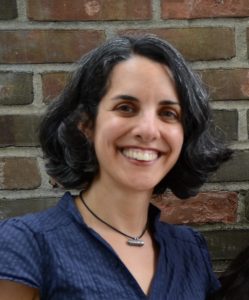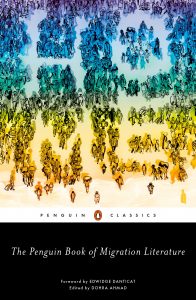The PEN Ten: An Interview with Dohra Ahmad
The PEN Ten is PEN America’s weekly interview series. This week, Lily Philpott speaks with Dohra Ahmad, editor of The Penguin Book of Migration Literature (Penguin Classics, 2019).

Photo by Orin Herskowitz
1. What does your creative process look like? How do you maintain momentum and remain inspired?
With The Penguin Book of Migration Literature, I never had a problem with momentum or inspiration—if anything, the main challenge was to stop reading, make my final decisions, and get them to the publisher. There was so much else that could have gone into the collection, all of it compelling and worthwhile. I was grateful to have a fantastic group of test readers, which was my Comparative Migration Literature undergrad class at St. John’s University. Because of them, I was able to see which pieces resonated across a broad group of readers with varied taste.
2. What was the first book or piece of writing that had a profound impact on you?
I read Toni Morrison’s The Bluest Eye on a Greyhound bus when I was in high school. I was blown away by the formal audacity of Morrison’s novel, the painful beauty of her language, and the power of the topic.
“To my mind, the biggest threat to free expression has always been, and will continue to be, unequal access to publication and publicity.”
3. What is one book or piece of writing you love that readers might not know about?
I can go back to NourbeSe Philip’s innovative, challenging poem “Discourse on the Logic of Language” hundreds of times and still learn more from it. It’s an amazing collage about slavery, colonialism, patriarchy, and their linguistic residues; and about how a poet can find her voice and her sense of self through and against those residues.
4. What is your favorite bookstore, or library?
I’m a big fan of the Brooklyn Public Library system—and all public libraries, in fact. My local branch on Pacific Street is a friendly and welcoming space. It’s tiny, but patrons can request that any circulating book be sent there, which was incredibly helpful as I tried to read all the migration literature I could find!
 5. What do you consider to be the biggest threat to free expression today? Have there been times when your right to free expression has been challenged?
5. What do you consider to be the biggest threat to free expression today? Have there been times when your right to free expression has been challenged?
To my mind, the biggest threat to free expression has always been, and will continue to be, unequal access to publication and publicity. I write in English; I live in New York; and I work at a university; therefore it hasn’t been too hard for me to find venues to get my ideas out. But I spend a lot of time thinking about the people that we’re not hearing from.
6. How can writers affect resistance movements?
Writers can start, sustain, refocus, and re-energize resistance movements. Resistance happens through the body and through language, so writers can shape and direct it in infinite ways. Especially in times like ours that are characterized by egregious social injustice, writing with honesty and purpose necessarily means resisting the current political order.
7. How does your editing practice navigate truth? What is the relationship between truth and fiction?
When I was selecting pieces for The Penguin Book of Migration Literature, I wasn’t really thinking about which were fiction and which were nonfiction. I was just looking for beautiful storytelling that captured a diversity of experiences. I loved being able to include first-person writing across many genres, from Safia Elhillo’s intricate poem “origin stories (reprise);” to Francisco Jiménez’s autobiography in vignettes; The Circuit to Marjane Satrapi’s graphic memoir Persepolis 2; to Zadie Smith’s semi-autobiographical fiction in White Teeth. Each of these, along with the other selections in The Penguin Book of Migration Literature, conveys a different facet of the multi-sided truth of migration.
“Writers can start, sustain, refocus, and re-energize resistance movements. Resistance happens through the body and through language, so writers can shape and direct it in infinite ways.”
8. How does your identity shape your writing?
As a person of mixed heritage (US Jewish and Pakistani Muslim), I tend to see two or more sides to every situation. Therefore I sometimes have trouble with thesis-driven writing (like my Ph.D. dissertation, which was tough for me). I have a much better time working on anthologies and other forms that accommodate multiple perspectives and competing truths.
9. What is the last book you read? What are you reading next?
I had been meaning to read Julia Alvarez’s In the Time of the Butterflies for years. When I finally got there, I found it gripping and gorgeously crafted. I understand history better through literature, and this novel gave me a valuable counterpoint to other fictional versions I’d read of daily life during the U.S.-backed Trujillo dictatorship. Next, I’ve just started reading Min Jin Lee’s similarly sweeping and historically grounded Pachinko.
10. The Penguin Book of Migration Literature, which you edited this year, features an incredible line-up of writers—from Phillis Wheatley to Zadie Smith, from across the globe and from throughout history. How did you select the writers featured in the collection? Where did you start? At which point did you feel that you had a representative selection of migration literature?
I started by planning out four sections for the collection: Departures, Arrivals, Generations, and Returns. There were some specific scenarios and dilemmas that I wanted to make sure appeared: Should I stay in my home country, or uproot my entire life? How does this new place compare with my expectations of it? What will my kids be like when they grow up there? Will I ever go home again—or is this new place my home now? I also wanted to make sure and include some specific historical phenomena, like slavery, indentureship, and civil war. At the same time, I was looking for vibrant, emotional, well-structured pieces. So there were a lot of factors in play. Ultimately, for every piece that I put in, there were hundreds of others that I could have used, which is why I was happy to have a chance to end the collection with a 20-page “Suggestions for Further Reading and Viewing.” In fact, I’m adding to that list all the time—take a look at https://migrationliterature.weebly.com/, and tell me what else I should put on!
Dohra Ahmad is professor of English at St. John’s University. She is the author of Landscapes of Hope: Anti-Colonial Utopianism in America (2009) and editor of Rotten English: A Literary Anthology (2007). She’s also written the introduction to the Penguin Classics edition of The Housing Lark (January 14, 2020).






